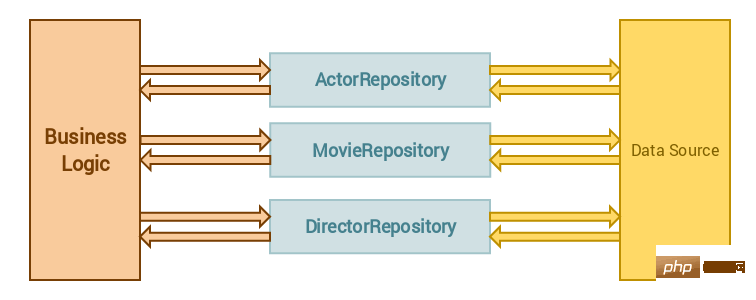Teach you how to apply the Repository design pattern in Laravel5.8
The following tutorial column will introduce to you how to correctly apply the Repository design pattern in Laravel 5.8. I hope it will be helpful to friends in need!
In this article, I will show you how to implement therepository design pattern from scratch in Laravel. I will be using Laravel version 5.8.3, but Laravel version is not the most important. Before you start writing code, you need to know some information about
design pattern from scratch in Laravel. I will be using Laravel version 5.8.3, but Laravel version is not the most important. Before you start writing code, you need to know some information about
design patterns.
repository Design patterns allow you to work with objects without knowing how those objects are persisted. Essentially, it is an abstraction of the data layer.
Design patterns allow you to work with objects without knowing how those objects are persisted. Essentially, it is an abstraction of the data layer.
This means that your business logic does not need to know how to retrieve the data or what the data source is, the business logic relies on the repository to retrieve the correct data.
Regarding this pattern, I have seen some misunderstanding it as repository being used to create or update data. This is not what
repositoryis supposed to do, repository is not supposed to create or update data, only to retrieve it. Do you understand? Let’s write the code together
Since we’re starting from scratch, let’s create a new Laravel project: composer create-project --prefer-dist laravel/laravel repository
Copy after loginFor this tutorial, we will build a small blogging application. Now that we have created a new Laravel project, we should create a controller and model for it.
composer create-project --prefer-dist laravel/laravel repository
php artisan make:controller BlogController
This will create the
BlogControllerin the
app/Http/Controllers directory. php artisan make:model Models/Blog -m
option will create a corresponding database migration. You can find the generated migration in the *database/migrations directory. *Now you should be able to find the newly generated model Blog in the
directory. This is just a way I like to store my models. Now that we have our controller and model, it’s time to look at the migration file we created. In addition to the default Laravel timestamp fields, our blog only requires the Title, Content, and
UserID fields. <?php
use Illuminate\Support\Facades\Schema;use Illuminate\Database\Schema\Blueprint;use Illuminate\Database\Migrations\Migration;class CreateBlogsTable extends Migration{
public function up()
{
Schema::create('blogs', function (Blueprint $table) {
$table->bigIncrements('id');
$table->string('title');
$table->text('content');
$table->integer('user_id');
$table->timestamps();
$table->foreign('user_id')
->references('id')
->on('users');
});
}
public function down()
{
Schema::dropIfExists('blogs');
}}
$table->bigIncrements('id');
with:
$table->increments('id');
Set up the database
I will use the MySQL database as an example, the first step is to create a new database.
mysql -u root -p create database laravel_repository;
The above command will create a new database called laravel_repository. Next we need to add database information to the
file in the Laravel root directory. DB_DATABASE=laravel_repositoryDB_USERNAME=rootDB_PASSWORD=secret
php artisan config:clear
Run the migration
Now we have After setting up the database, you can start running the migration: php artisan migrate
Copy after loginThis will create the
blogsphp artisan migrate
table, which contains the
title, we declared in the migration. content and user_id fields. Implementation
repositoryDesign patternEverything is ready, we can now start to implement the repository design style. We will create the
Repositoriesdirectory inside the app directory. The second directory we will create is the Interfaces directory, which is located within the Repositories directory. In the Interfaces file we will create a
BlogRepositoryInterfaceinterface that contains two methods. Returns the all
method of all blog posts- Returns the getByUser method of all blog posts of a specific user
- The last class we need to create is BlogRepository
<?php namespace App\Repositories\Interfaces;use App\User;interface BlogRepositoryInterface{ public function all(); public function getByUser(User $user);}Copy after login that will implement
, and we will write the simplest implementation. <?php
namespace App\Repositories;use App\Models\Blog;use App\User;use App\Repositories\Interfaces\BlogRepositoryInterface;class BlogRepository implements BlogRepositoryInterface{
public function all()
{
return Blog::all();
}
public function getByUser(User $user)
{
return Blog::where('user_id',$user->id)->get();
}}
app/└── Repositories/
├── BlogRepository.php
└── Interfaces/
└── BlogRepositoryInterface.phpYou have now successfully created a repository. But we're not done yet, it's time to start using our
repository. 要开始使用 BlogRepository ,我们首先需要将其注入到 BlogController 。由于 Laravel 的依赖注入,我们很容易用另一个来替换它。这就是我们控制器的样子: 如你所见,控制器中的代码很简短,可读性非常的高。不需要十行代码就可以获取到所需的数据,多亏了 repository ,所有这些逻辑都可以在一行代码中完成。这对单元测试也很好,因为 repository 的方法很容易复用。 repository 设计模式也使更改数据源变得更加容易。在这个例子中,我们使用 MySQL 数据库来检索我们的博客内容。我们使用 Eloquent 来完成查询数据库操作。但是假设我们在某个网站上看到了一个很棒的博客 API,我们想使用这个 API 作为数据源,我们所要做的就是重写 BlogRepository 来调用这个 API 替换 Eloquent 。 我们将注入 BlogController 中的 BlogRepository ,而不是注入 BlogController 中的 BlogRepositoryInterface ,然后让服务容器决定将使用哪个存储库。这将在 AppServiceProvider 的 boot 方法中实现,但我更喜欢为此创建一个新的 provider 来保持整洁。 我们为此创建一个新的 provider 的原因是,当您的项目开始发展为大型项目时,结构会变得非常凌乱。设想一下,一个拥有 10 个以上模型的项目,每个模型都有自己的 repository ,你的 AppServiceProvider 可读性将会大大降低。 我们的 RepositoryServiceProvider 会像下面这样: 留意用另一个 repository 替代 BlogRepository 是多么容易! 不要忘记添加 RepositoryServiceProvider 到 config/app.php 文件的 providers 列表中。完成了这些后我们需要清空缓存: 现在你已经成功实现了 repository 设计模式,不是很难吧? 你可以选择增加一些路由和视图来拓展代码,但本文将在这里结束,因为本文主要是介绍 repository 设计模式的。 如果你喜欢这篇文章,或者它帮助你实现了 repository 设计模式,请确保你也查看了我的其他文章。如果你有任何反馈、疑问,或希望我撰写另一个有关 Laravel 的主题,请随时发表评论。 The above is the detailed content of Teach you how to apply the Repository design pattern in Laravel5.8. For more information, please follow other related articles on the PHP Chinese website!在控制器中使用 Repository
<?php
namespace App\Http\Controllers;use App\Repositories\Interfaces\BlogRepositoryInterface;use App\User;class BlogController extends Controller{
private $blogRepository;
public function __construct(BlogRepositoryInterface $blogRepository)
{
$this->blogRepository = $blogRepository;
}
public function index()
{
$blogs = $this->blogRepository->all();
return view('blog')->withBlogs($blogs);
}
public function detail($id)
{
$user = User::find($id);
$blogs = $this->blogRepository->getByUser($user);
return view('blog')->withBlogs($blogs);
}}RepositoryServiceProvider
php artisan make:provider RepositoryServiceProvider
<?php
namespace App\Providers;use App\Repositories\BlogRepository;use App\Repositories\Interfaces\BlogRepositoryInterface;use Illuminate\Support\ServiceProvider;class RepositoryServiceProvider extends ServiceProvider{
public function register()
{
$this->app->bind(
BlogRepositoryInterface::class,
BlogRepository::class
);
}}'providers' => [
//测试¥¥¥¥¥¥¥¥¥¥¥¥¥¥¥¥¥
\App\Providers\RepositoryServiceProvider::class],php artisan config:clear
就是这样

Hot AI Tools

Undresser.AI Undress
AI-powered app for creating realistic nude photos

AI Clothes Remover
Online AI tool for removing clothes from photos.

Undress AI Tool
Undress images for free

Clothoff.io
AI clothes remover

AI Hentai Generator
Generate AI Hentai for free.

Hot Article

Hot Tools

Notepad++7.3.1
Easy-to-use and free code editor

SublimeText3 Chinese version
Chinese version, very easy to use

Zend Studio 13.0.1
Powerful PHP integrated development environment

Dreamweaver CS6
Visual web development tools

SublimeText3 Mac version
God-level code editing software (SublimeText3)

Hot Topics
 1378
1378
 52
52
 Comparison of the latest versions of Laravel and CodeIgniter
Jun 05, 2024 pm 05:29 PM
Comparison of the latest versions of Laravel and CodeIgniter
Jun 05, 2024 pm 05:29 PM
The latest versions of Laravel 9 and CodeIgniter 4 provide updated features and improvements. Laravel9 adopts MVC architecture and provides functions such as database migration, authentication and template engine. CodeIgniter4 uses HMVC architecture to provide routing, ORM and caching. In terms of performance, Laravel9's service provider-based design pattern and CodeIgniter4's lightweight framework give it excellent performance. In practical applications, Laravel9 is suitable for complex projects that require flexibility and powerful functions, while CodeIgniter4 is suitable for rapid development and small applications.
 How do the data processing capabilities in Laravel and CodeIgniter compare?
Jun 01, 2024 pm 01:34 PM
How do the data processing capabilities in Laravel and CodeIgniter compare?
Jun 01, 2024 pm 01:34 PM
Compare the data processing capabilities of Laravel and CodeIgniter: ORM: Laravel uses EloquentORM, which provides class-object relational mapping, while CodeIgniter uses ActiveRecord to represent the database model as a subclass of PHP classes. Query builder: Laravel has a flexible chained query API, while CodeIgniter’s query builder is simpler and array-based. Data validation: Laravel provides a Validator class that supports custom validation rules, while CodeIgniter has less built-in validation functions and requires manual coding of custom rules. Practical case: User registration example shows Lar
 Which one is more beginner-friendly, Laravel or CodeIgniter?
Jun 05, 2024 pm 07:50 PM
Which one is more beginner-friendly, Laravel or CodeIgniter?
Jun 05, 2024 pm 07:50 PM
For beginners, CodeIgniter has a gentler learning curve and fewer features, but covers basic needs. Laravel offers a wider feature set but has a slightly steeper learning curve. In terms of performance, both Laravel and CodeIgniter perform well. Laravel has more extensive documentation and active community support, while CodeIgniter is simpler, lightweight, and has strong security features. In the practical case of building a blogging application, Laravel's EloquentORM simplifies data manipulation, while CodeIgniter requires more manual configuration.
 Laravel - Artisan Commands
Aug 27, 2024 am 10:51 AM
Laravel - Artisan Commands
Aug 27, 2024 am 10:51 AM
Laravel - Artisan Commands - Laravel 5.7 comes with new way of treating and testing new commands. It includes a new feature of testing artisan commands and the demonstration is mentioned below ?
 Laravel vs CodeIgniter: Which framework is better for large projects?
Jun 04, 2024 am 09:09 AM
Laravel vs CodeIgniter: Which framework is better for large projects?
Jun 04, 2024 am 09:09 AM
When choosing a framework for large projects, Laravel and CodeIgniter each have their own advantages. Laravel is designed for enterprise-level applications, offering modular design, dependency injection, and a powerful feature set. CodeIgniter is a lightweight framework more suitable for small to medium-sized projects, emphasizing speed and ease of use. For large projects with complex requirements and a large number of users, Laravel's power and scalability are more suitable. For simple projects or situations with limited resources, CodeIgniter's lightweight and rapid development capabilities are more ideal.
 Laravel vs CodeIgniter: Which framework is better for small projects?
Jun 04, 2024 pm 05:29 PM
Laravel vs CodeIgniter: Which framework is better for small projects?
Jun 04, 2024 pm 05:29 PM
For small projects, Laravel is suitable for larger projects that require strong functionality and security. CodeIgniter is suitable for very small projects that require lightweight and ease of use.
 Which is the better template engine, Laravel or CodeIgniter?
Jun 03, 2024 am 11:30 AM
Which is the better template engine, Laravel or CodeIgniter?
Jun 03, 2024 am 11:30 AM
Comparing Laravel's Blade and CodeIgniter's Twig template engine, choose based on project needs and personal preferences: Blade is based on MVC syntax, which encourages good code organization and template inheritance. Twig is a third-party library that provides flexible syntax, powerful filters, extended support, and security sandboxing.
 Laravel - Artisan Console
Aug 27, 2024 am 10:51 AM
Laravel - Artisan Console
Aug 27, 2024 am 10:51 AM
Laravel - Artisan Console - Laravel framework provides three primary tools for interaction through command-line namely: Artisan, Ticker and REPL. This chapter explains about Artisan in detail.




